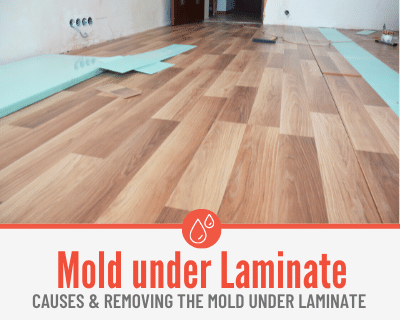Mold Growing under your Laminate flooring can be quite devasting. It can not only cause issues with laminate but also cause various health problems.
In this guide you will learn:
- How to Tell if there might be mold under your laminate flooring,
- Common Causes & Dangers of mold growing under laminate,
- How to Remove Mold under your Laminate flooring,
- How to Prevent mold growing under your Laminate in the future.

How Do I Know If I Have Mold Under My Laminate Flooring?
The first step to getting rid of and preventing mold under your laminate flooring is learning how to identify that it’s there. Below are some of the common signs to look out for.
- Bad smell – An easy way to tell if there’s mold growing under your laminate flooring is to see if there’s a bad smell in the room. Mold usually gives off a pretty strong musty scent, so you should be able to recognize it almost immediately.
- Warping or distortion – A pretty obvious sign of mold will be warped or distorted laminate flooring. This is because mold needs moisture to grow, and water often warps laminate if a lot is present. In extreme cases, the growth may be significant enough that the mold itself will start to lift the panels, but this is quite rare.
- Discoloration – If your laminate flooring suddenly has patches of discoloration all over it, you may have mold growing underneath. This does depend on the severity of the infestation though, so it’s not a failproof method of detection. If the laminate is relatively old, for example, it can naturally become discolored from people walking over it regularly.
- Visible mold – In very severe cases, you may actually see some mold on the surface of your laminate flooring. This usually happens when there’s enough mold to eat through the laminate or to squeeze through the minuscule spaces in between laminate panels.
- Cracks and physical damage – Again, this usually only appear with quite severe or advanced cases of mold infestation, but you may notice sudden cracks or holes appearing in your laminate flooring. This likely means that there’s mold growing underneath and eating away at the panels above it.
Can You Check For Mold Under Laminate Without Removing It?
While the methods above can give you a pretty good indication of whether you have mold under your laminate flooring, it is quite tricky to be 100% sure without removing the laminate.
If your laminate flooring is the glue-less type that simply clicks together, you should be able to just slightly pry up one corner to check if there is any mold underneath, rather than removing the whole thing.
Mold under your Laminate Flooring?
Call 844-488-0570 for a Risk Free estimate from a Licensed Mold Remediation Specialist in your area.
We Can Help Remove the Mold under your Laminate & Prevent it from Returning!
Common Causes Of Mold Under Laminate Flooring
Knowing the common causes behind mold growing under your laminate can help you to prevent unwanted infestations.
You’ll be able to avoid creating an environment that sustains mold and you’ll probably save some money while you’re at it – replacing damaged laminate flooring can get expensive if you need to buy lots of panels!
Continue Reading: How to Repair Water Damaged Laminate Flooring
While we can’t cover every single cause, here’s a list of the most likely ones:
Excessive moisture
Moist environments are breeding grounds for all sorts of mold and bacteria, so if there’s any sort of water present under your laminate flooring you’ll probably find some mold growth.
Excessive moisture can be caused by several scenarios, with the most common being flooding the area with water due to a leak or consistently spilling water there. Therefore rooms like the bathroom and kitchen are most likely to experience mold.
Another cause can simply be the climate you live in – if you live somewhere that sees a lot of rainfall and humidity, you may be at a higher risk of developing mold under your laminate flooring.
Previous mold infestations
Believe it or not, previous mold infestations can return if they weren’t removed properly.
This is particularly common in older homes that were recently renovated – some people may take the easy route out and simply cover up previously damaged or moldy floors, leaving the next owner or tenant to potentially deal with the consequences.
Contaminated furniture
While this cause is rarer than the other two mentioned in this guide, it’s still very plausible.
Furniture contaminated by mold spores, either due to being previously infested by mold or harboring the correct conditions for mold growth (moisture and warmth), can spread those spores to your laminate flooring.
Is Mold Under Laminate Flooring Dangerous?
Danger To Your Health
Having mold in your home can be very dangerous for your health. Prolonged exposure to mold spores can cause a range of health issues, including dizziness, allergic reactions, and lung infections.
Young children, older people, and those suffering from asthma and other lung-related diseases are at a very high risk of health complications as a result of exposure to mold spores.
Damage To Your House
Mold can also severely damage your home. If it’s under your laminate flooring, it can cause the panels to warp and become discolored, forcing you to completely replace them. It can even eat away at the panels, causing physical damage like cracks to appear.
If gone untreated for too long, the mold spores may spread from under your flooring to nearby furniture and walls, causing even more damage in the long run. Also, the affected room will eventually develop a nasty smell, which is the last thing you want!

How To Remove Mold Under Laminate Flooring
Now, once you’ve determined that there’s mold growing under your floor, you’re going to want to get rid of it as quickly as possible.
Untreated mold infestations can grow substantially in size, rapidly spreading to nearby furniture and surfaces, so make sure to follow the steps below to remove the mold completely!
- Remove any furniture – Before you start worrying about getting under that laminate flooring, make sure to get any furniture out of the room. This is to make the cleaning process easier, but also to make sure that any loose mold spores don’t attach to the furniture and continue growing.
- Remove the laminate flooring – Start from a corner near the affected area and carefully pry up the laminate flooring, section by section. You may need to use a small knife or wide putty knife to help pry the laminate up. Depending on how widespread the mold infestation is, you may be able to get away with removing just a few panels. Otherwise, you’ll need to remove all of the flooring in the room.
- Throw away contaminated panels – You should absolutely throw away all of the laminate panels that were contaminated by the mold, and probably any adjacent ones too, just in case. Re-using panels that were touching the mold will result in the infestation coming back.
- Clean the moldy area – Saturate the moldy area with a solution of bleach and water, then scrub it thoroughly with a sponge or soft bristle brush. You may need to repeat this step a few times, depending on how much mold there is.
- Dry the area – Once you’re done scrubbing, make sure to dry the area carefully, to ensure that there’s no moisture left behind. We recommend using some heat and dehumidifiers if you had to clean a large area.
- Replace the laminate flooring – The final step is to replace the laminate flooring you removed earlier. As stated before, we highly recommend not re-using the panels that were there before as you run the risk of the mold infestation returning, so just purchase some new ones to place down.
How To Prevent Mold Under Laminate Flooring In The Future
Now that you’ve removed the mold from under your laminate flooring, you’re going to want to make sure it never returns. So, how do you do it?
- Protect your flooring from moisture – In general, you should avoid having laminate flooring in areas that see a lot of moisture, like bathrooms, as it’s not water-resistant enough. If you have no choice though, make sure to mop up any standing water as soon as you notice it and keep the floor as dry as possible.
- Ensure good airflow in the room – High temperatures and humidity in a room can increase the chances of a mold infestation developing under the laminate flooring. By keeping the windows open and the heaters at a low temperature, you can reduce the risk of this happening.
- Invest in dehumidifiers – Apart from using them to dry out the floor after you’ve gotten rid of the mold, you can also use dehumidifiers to ensure the area doesn’t get too moist. Dehumidifiers are especially helpful if you live in a relatively wet climate and can’t otherwise reliably control the moisture in your home.
When To Call A Professional?
Removing mold from beneath your laminate flooring should be easy enough for you do to it by yourself. As long as you clean the area thoroughly and get rid of any contaminated items, you should also be able to prevent the infestation from happening again.
However, if the affected area proves too big to tackle by yourself or the mold keeps returning despite your best efforts, we recommend calling a professional.
They’ll be able to help you clean the area thoroughly using specialist equipment and help come up with a plan to prevent the mold from recurring.
We have Mold Remediation Technicians that can help you Get rid of the Mold, Restore any Mold damage, and Prevent it from Returning in the future.
For Disasters of all Sizes, available in 95% of the USA.
